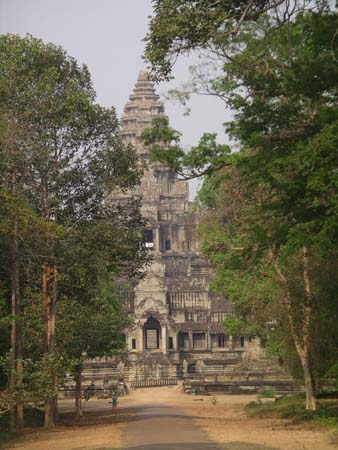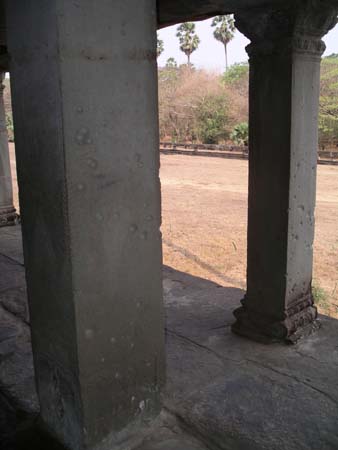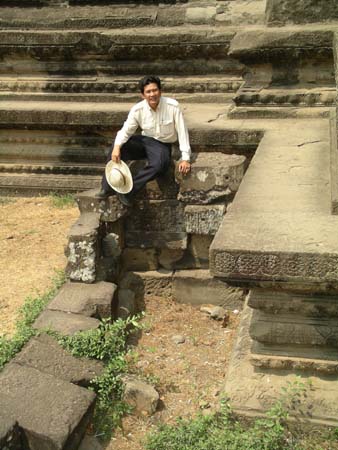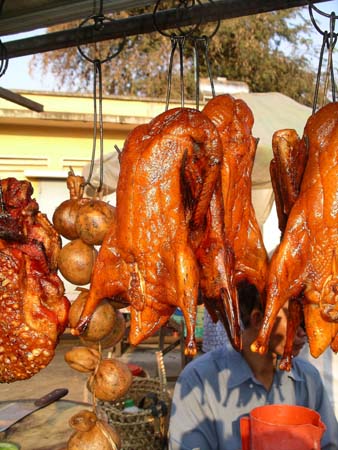Friday, March 12
Paula and Steve: Following Thy's grand plan for our time
here in Siem Reap, we saved our exploration of Angkor Wat for our final day
(we have one more day left here, but today was our last day for exploring
temples). We now realize that there's so much more to this area than the actual
Angkor Wat temple, yet the term "Angkor Wat" is what people use
to de scribe
the entire amazing cluster of Khmer temples that surround Siem Reap.
scribe
the entire amazing cluster of Khmer temples that surround Siem Reap.
As has been the case with each place we've seen, Thy carefully orchestrated
our entry into Angkor Wat. We entered its from its rear gate, providing us
with a spectacular first glimpse of its imposing towers through an enclosed
doorway. The surrounding jungle and sounds of cuckoo birds and buzzing cicadas
created an atmosphere where we could almost imagine what this place was like
back in the 12th century when it was built. There were no other visitors in
this part of the temple (too early for people to have made it here yet), which
was great. A perfect start!
Angkor Wat was built by King Suryavarman II in honor of the Hindu God Vishna.
It has five enormous towers and six libraries. In the 16th century it was
converted into a Buddhist temple and was car ed
for by monks until the war years. While the other temples of the Khmer Empire
where abandoned after the fall of the empire in the 15th century, Angkor Wat
has been continually occupied. Buddhists come from all over the world to visit
Angkor Wat and believe that the "future Buddha" will be enlightened
here in this temple someday.
ed
for by monks until the war years. While the other temples of the Khmer Empire
where abandoned after the fall of the empire in the 15th century, Angkor Wat
has been continually occupied. Buddhists come from all over the world to visit
Angkor Wat and believe that the "future Buddha" will be enlightened
here in this temple someday.
Angkor Wat is impressive partly because of its size. Thy told us that the project required 40,000 elephants and 700 bamboo rafts to carry the sandstone, as well as over 6,000 architects and 400,000 craftsmen to complete the work over a 40-year period. The dimensions of the temple are 195 meters by 205 meters making it the largest in the world. The entire complex including the gates and moat are set on over 208 hectares. Unlike Angkor Thum, this complex was reserved exclusively for the high priests and king - no other people lived within the walls.
An artificial hill was built from the earth dug out to make the huge moat.
This was done to recreate the mythical Mount Meru from the Hindu's interpretation
of the cosmos. As we entered the temple area and passed by several nargas
(the mythical seven headed cobras), Thy told us we were entering the area
of Angkor Wat that represents "heaven." Almost immediately, we found
ourselves in front of one of the 8 beautiful bas-reliefs in Angkor Wat depicting
the stories of the Ramayana (Hindu holy book). We mar veled
at the carvings as Thy showed and explained to us one of the stories about
King Rama's desire to build a bridge across the
veled
at the carvings as Thy showed and explained to us one of the stories about
King Rama's desire to build a bridge across the Indian Ocean to bring back his wife Sita who had been taken by the King of
Lanka. Rama had to collaborate with the Monkey King, Hanuman. who married
a mermaid in order to get the bridge built. Thy told us that this is a common
"bedtime story" told to children in Cambodia even today. The gallery
is well preserved and we could even see areas where its original red color
is still evident. Some of the areas in the relief are shiny and Thy said this
was from people touching them for good luck
Indian Ocean to bring back his wife Sita who had been taken by the King of
Lanka. Rama had to collaborate with the Monkey King, Hanuman. who married
a mermaid in order to get the bridge built. Thy told us that this is a common
"bedtime story" told to children in Cambodia even today. The gallery
is well preserved and we could even see areas where its original red color
is still evident. Some of the areas in the relief are shiny and Thy said this
was from people touching them for good luck  (UNESCO
is considering putting up glass to prevent this from happening).
(UNESCO
is considering putting up glass to prevent this from happening).
Angkor Wat's 5 central towers each represent a Hindu god or goddess, and
are also each associated with specific nearby mountain peaks. These towers
appear at each corner of the inside of the temple, with an additional tower in the middle.
Looking straight at the temple from the front or back, only 3 of the towers
are visible.
corner of the inside of the temple, with an additional tower in the middle.
Looking straight at the temple from the front or back, only 3 of the towers
are visible.
As we examined some of the 1,500 apsaras (dancers for the Gods), we couldn't
help but notice signs of the many years of war that Cambodia has endured in
its recent past. There are many bullet holes that are scattered throughout
the temple especially along the outer pillars, some still containing bullets.
In the early 1970's, there was much fighting in this area between the government
and the Khmer Rouge. Later, in its battles with the Khmer Rouge, the Vietnamese
used Angkor Wat for the storage of  military
equipment.
military
equipment.
There is also much evidence of stolen artifacts, including faces that have
been removed from sculptures and carvings, and over 100,000 Buddhas that were
once here but are now missing. Thy explained that some of the damage  occurred
when the Khmer Rouge was fighting to take over the Republic and other damage
was done during the Vietnamese occupation.
occurred
when the Khmer Rouge was fighting to take over the Republic and other damage
was done during the Vietnamese occupation.
People from the nearby villages sought protection inside Angkor Wat during the years of fighting in 1974 and 1976 and Thy explained that he lived with his mother in one corner of Angkor Wat during this time period when he was just a small boy. He showed us exactly where this spot is, and we took a picture of him there.
 Before
leaving Angkor Wat, we lit incense for Vishnu, whose statute stands near the
entrance of the temple. This statue used to be in the central part of Angkor
Wat, but was moved here after the temple became Buddhist. Thy explained that
the head of this statue had once been stolen and then recovered. Recently,
it has just been returned in the past month after being kept in the National
Museum for over 20 years.
Before
leaving Angkor Wat, we lit incense for Vishnu, whose statute stands near the
entrance of the temple. This statue used to be in the central part of Angkor
Wat, but was moved here after the temple became Buddhist. Thy explained that
the head of this statue had once been stolen and then recovered. Recently,
it has just been returned in the past month after being kept in the National
Museum for over 20 years.
As we left Angkor Wat, we saw a library which is being restored. Thy explained that the process is very slow and will take at least 10 years (this one was started in 1995, and doesn't look close to being completed). UNESCO now manages the restoration processes because in the past, accidental damage has been caused by some of the countries helping to restore various temples in the Angkor area. Many countries are involved in the restoration of the temples including France, Germany, Japan, Italy, India and China.
 Our
visit to Angkor Wat was a wonderful conclusion to our exploration of the Khmer
temples. Each place has its own fascinating history, mysteries and interesting
characteristics. Angkor Wat, especially with its huge size and impressive
towers, was a very fitting way to complete our journey back to the days of
the Khmer Empire.
Our
visit to Angkor Wat was a wonderful conclusion to our exploration of the Khmer
temples. Each place has its own fascinating history, mysteries and interesting
characteristics. Angkor Wat, especially with its huge size and impressive
towers, was a very fitting way to complete our journey back to the days of
the Khmer Empire.
After our standard mid-afternoon break for rest, swimming and general relaxation,
we set out to explore Siem Reap and its local markets. Siem Reap is the second
largest city in Cambodia with 40,000 residents (and only 2 traffic lights!),
most of whom are farmers. The town is fairly quiet during the heat of the
day, but by late afternoon things become much  more
active. We first toured the "Old Market" where we purchased some
souvenirs to take home from Cambodia. It's interesting to see how these shops
work in each new country - here in C
more
active. We first toured the "Old Market" where we purchased some
souvenirs to take home from Cambodia. It's interesting to see how these shops
work in each new country - here in C ambodia,
it was a return to the hard-sell of India. People are very eager to sell,
and negotiate heavily.
ambodia,
it was a return to the hard-sell of India. People are very eager to sell,
and negotiate heavily.
After finishing our own shopping, we set out to explore how Cambodians shop
and eat in the local markets. We love spending time in markets, especially
in new countries, because we always seem to see new and interesting foods,
products and services being offered. Today was no exception. First we saw
women selling bugs in large bowls. Some of these bugs were huge, and Thy told
us that there is no English word for them. Most live in the mud, and are normally
fried. We understand that crickets are a real treat, but that they're out
of season (they're plentiful during the wet season). No matter - the bugs
we saw today looked plenty tasty.
saw today looked plenty tasty.
We stopped for a quick snack in a restaurant that Thy told us is famous with
Cambodians. Thy ordered us a bowl of duck soup with noodles, a staple meal
for the locals. We all enjoyed another new taste experience, and Katie was
the bravest of all, trying some of the duck blood that is cooked and forms
soft chunks floating in the soup. We  also
drank traditional Cambodian ice tea, which is loaded with sugar and lime juice.
also
drank traditional Cambodian ice tea, which is loaded with sugar and lime juice.
A small street vendor was selling purge sugar cane juice that he was pressing
from a small machine. He filled small plastic bags with a mixture of ice and
the sugar juice - this is a favorite taste treat here, especially for children.
We purchased a bag, and it was very tasty (but much  too
sweet!).
too
sweet!).
Next we saw how Cambodians like to eat baby ducks that are still in their eggs. They are heated and eaten whole. Thy demonstrated how the egg is opened and the parts of the baby duck. Paula and Katie chose not to watch… Ducks are a very common food here, and we also saw several whole ducks (roasted) for sale.
As we walked through the heart of Siem Reap's local market, we also saw many
places with huge blocks of ice for sale where men use hand saws to cut the
ice into  smaller
chunks. This ice is purchased by people to keep one day's worth of food cold,
since most don't have refrigerators. People come to buy food from the market
every day, buying just enough for that day's meals.
smaller
chunks. This ice is purchased by people to keep one day's worth of food cold,
since most don't have refrigerators. People come to buy food from the market
every day, buying just enough for that day's meals.
Most people ride motorbikes (cars are too expensive), and we s aw
a small street-side "gas station." This was a lady who siphoned
gasoline in to plastic Coke bottles that were then sold to people for their
motorbikes.
aw
a small street-side "gas station." This was a lady who siphoned
gasoline in to plastic Coke bottles that were then sold to people for their
motorbikes.
Siem Reap's markets are filled with all kinds of sidewalk restaurants. These are people who set up displays of prepared foods where people can select a meal and eat right there on plastic chairs and tables. Noodle soups are popular, as are various Cambodian soups and stir-fry dishes. Most of the prepared meals are stews containing mixtures of various meats, seafood, and vegetables.
 As
usual, there is also a wide variety of meats, fruits, vegetables, nuts and
seafood for sale. It's always fascinating to see the types of food being sold,
and amazing to think about how it all gets sold and totally replenished every
single day.
As
usual, there is also a wide variety of meats, fruits, vegetables, nuts and
seafood for sale. It's always fascinating to see the types of food being sold,
and amazing to think about how it all gets sold and totally replenished every
single day.
As we walked through Siem Reap's markets, we were constantly approached by people begging for money - it was our first experience with this since our time in India. Many of these people look to have been wounded in recent wars or by land mines, and some of the people begging are mothers carrying their naked children. We also saw evidence of some of the extreme poverty here, especially the shacks located along the Siem Reap River, crowded on dirty streets and crammed with people.
Tomorrow we'll be exploring more of Siem Reap and its surrounding areas. In the morning we are headed to Tonle Sap Lake, a huge freshwater body of water that the Mekong River actually backs up into during the rainy season. In the afternoon we are going to visit one of Cambodia's killing fields, containing a memorial for the victims of the Khmer Rouge regime.
